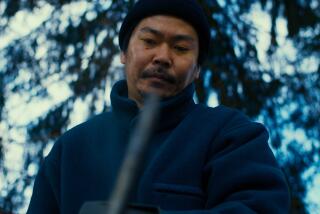Tide of Anger at Japan’s Parched Wetlands
- Share via
ISAHAYA, Japan — For thousands of years, the Isahaya wetlands in southern Japan teemed with exotic birds, rare fish and a rich, delicate ecosystem that sustained more than 500 species of sea life, some of them endangered.
Today, however, the parched and cracked seabed stinks with the smell of death. As far as the eye can see, what had been Japan’s largest and most important remaining tidal flat is now covered with thick beds of dead shellfish and rotting fish carcasses after the government in April shut off the sea in a controversial project to control flooding and reclaim agricultural land.
“This has become a graveyard,” local activist Hideharu Yamada says sadly, batting away growing swarms of mosquitoes that he and others fear may turn Isahaya into a health hazard. Yamada, an electrical firm employee provoked into joining his first citizens protest, bursts out: “This is crazy. Japan is crazy!”
*
The destruction of Isahaya’s wetlands for yet another controversial public works project--one critics say is primarily aimed at political payback to the influential construction industry--has sparked widespread protests, charges of violating international treaties and new questions about Japan’s commitment to environmental protection.
As Prime Minister Ryutaro Hashimoto prepares to address a U.N. conference today on Japan’s leadership role in tackling environmental problems abroad, activists say the nation must come to terms with its own checkered record at home.
“Japanese leadership? Rhetoric,” says Teiichi Aoyama of the Environmental Research Institute in Tokyo. “This country still prioritizes economic concerns over environmental ones.”
It was not always so. Once imbued with a delicate appreciation for nature--or so the national self-image held--the Japanese spawned a religion, Shinto, that worshiped the divine in mountains, streams and even rocks.
But such sensibilities, along with the physical environment, have rapidly changed since the onset of high-speed industrialization more than three decades ago. Now Japan--which is only 4% the size of the United States in land mass but consumes as much concrete per year--has destroyed more than one-third of its tidelands.
It has dammed all but two of its 109 major rivers, razed most of its old-growth forests and littered a once-breathtaking landscape with electric utility poles, concrete buildings and ubiquitous pachinko parlors.
Today, Japan’s environmental profile is marked by contrasting faces. Since the 1992 Earth Summit in Brazil, Japan has become the world’s largest donor of financial aid for overseas environmental projects--a total $12.8 billion, outstripping its original commitment by nearly 50%.
More than half the funds are dedicated to building water supply, waste-disposal and sewage systems, along with other projects to improve living environments, in places ranging from Peru to Mexico. But Japan also finances everything from anti-pollution centers in China and Thailand to reforestation projects in Indonesia.
Japan now boasts one of the cleanest industries in the world, having overcome the virulent industrial pollution of the 1950s and ‘60s that killed and disfigured scores of people through arsenic and mercury poisoning. The nation possesses superior antipollution technology. And despite its advanced industrialization, Japan emits, per person, just half the carbon dioxide--the gas responsible for the global warming phenomenon--that the U.S. does.
Hashimoto is expected to share some of Japan’s hard-won know-how in his U.N. speech today in New York, unveiling an “Initiative for Sustainable Development” that will address plans to combat global warming and acid rain and to preserve biodiversity and coral reefs.
“We’re actively trying to contribute to the world by grappling with environmental problems,” said Foreign Ministry official Shuichiro Kawaguchi. “Through our own economic development, we experienced various pollution problems that developing countries are now undergoing. We want to share that experience with the world.”
*
At the same time, however, Japan has come under fire for what critics call the wanton destruction of wildlife and natural habitats in a lopsided drive for development.
In particular, the nation has been criticized for corporate plundering of Southeast Asia’s timberlands, for threatening endangered species by seeking to revive trade in ivory, whale meat and tortoise shells, and for the sacrifice of its own natural environment at the altar of profits and political cronyism.
“The Japanese are very good at pollution-control technology, but leadership is not necessarily needed there--people know the technology exists,” says Richard Forrest, the National Wildlife Federation’s representative for East Asia.
“But once a species goes extinct, it can never be brought back,” he says. “We need leadership on important things, which is not losing irreplaceable resources.”
For many activists here, the Isahaya wetlands symbolize all that is wrong with environmental policymaking in Japan: construction projects of questionable value hatched among a collusive triangle of politicians, bureaucrats and industry; virtually no avenue for meaningful citizen input or debate on the merits of public plans; an environmental assessment process conducted by pro-development ministries; and little public disclosure of documents--or the deliberate hiding and distorting of them.
Officials first proposed the reclamation project--which uses steel-and-concrete barriers to shut out the sea--in 1952 as a way to increase farmland for a war-torn nation short of food. Today, however, Japan is awash in excess rice and aging farmers whose children do not want to dirty their hands tilling the land.
Like many towns throughout Japan, Isahaya--located about 10 miles northeast of Nagasaki--has drastically reduced its dependence on fishing and farming in favor of such high-tech industries as a Sony semiconductor plant. Just who will farm the reclaimed land is a question no one seems able to answer, although Isahaya city official Keisuke Ubayashi says 40% of farmers surveyed showed “interest” in the land.
In any case, officials are now stressing flood control as the main justification for the project. It is a topic that provokes emotional outpourings from old-time residents such as Chamber of Commerce Chairman Mitsuru Koba. He recalls the terror of heavy rains and rising rivers that swept away homes and several of his neighbors.
“In the floods of 1959, 539 people died. Isahaya residents have experienced firsthand the terror of natural disasters,” Koba says. “Of course we are sad to lose nature, but our safety comes first.”
He acknowledges that local industry is also hoping to profit from the project by building roads and related infrastructure. The sea wall constructed so far--more walls are planned--was built by a politically powerful consortium of at least 34 national construction giants.
There are questions, however, about citing flood control as justification for the project. A just-surfaced 1984 report conducted at the request of the Agriculture Ministry concluded that the project at its planned size would not effectively control floods. Officials had denied the report’s existence for 13 years until activist Hirobumi Yamashita tracked down one of the original authors and obtained it this year.
Yamashita also discovered that government officials secretly doctored an environmental assessment report to downplay the negative impacts of the project on Isahaya’s delicate ecosystem.
Such practices are not uncommon here: Aoyama of the environmental research firm says his own reports have been rewritten to deny impacts but that he and others dare not protest for fear of losing work. As a result, not one major public works project has been canceled or significantly revised because of a negative assessment, he says.
*
Indeed, Japan was the only advanced industrial nation without an environmental assessment law until this month, nearly 30 years after the United States’ landmark legislation. Experts say it is too weak to be effective.
Yamashita and others are fighting to reopen the sea gates, restore the tidelands and review the entire Isahaya project. He says the flooding problems could be solved by a smaller-scale reclamation project or by closing the gates only in times of heavy rain--options that would preserve most of the tidal flats.
The grizzled marine biologist has protested the project for 27 years despite first anonymous phone threats, then an offer of $268,000 from bureaucrats to drop his opposition. Although the government failed to persuade Yamashita, fisherman Katsuyoshi Fujita says he and others among his 2,000 fellow workers took the $290,000 offered each of them by the government a decade ago to drop their resistance and look for new jobs.
Although he feels twinges about his decision, Fujita says the money allowed him to send his son to college and give him a brighter future than the demanding, dirty work of a fisherman. He also says it was virtually useless to resist the powerful alliance of bureaucrats, politicians and industry.
“This is the way of public works in Japan,” Yamashita says. “Either they try to crush you through violence or buy you off with carrots.”
U.S., Australian and Russian environmental groups have joined the Japanese activists in calling for an investigation into whether the project violates international treaties protecting wetlands and migratory birds. Isahaya once gave refuge to more than 232 bird species--including the critically endangered black-faced spoonbill-- but the shores are now barren.
The environmental groups plan to capitalize on Hashimoto’s U.N. appearance, running an advertisement in the Earth Times newspaper with photos of the wetlands’ devastation. The ad will ask: “Is this what you call sustainable development, Mr. Hashimoto?”
Chiaki Kitada of The Times’ Tokyo Bureau contributed to this report.
More to Read
Sign up for Essential California
The most important California stories and recommendations in your inbox every morning.
You may occasionally receive promotional content from the Los Angeles Times.











